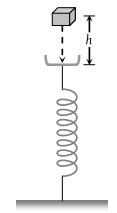A bomb of mass 3.0 Kg explodes in air into two pieces of masses 2.0 kg and 1.0 kg. The smaller mass goes at a speed of 80 m/s.The total energy imparted to the two fragments is
(1) 1.07 kJ
(2) 2.14 kJ
(3) 2.4 kJ
(4) 4.8 kJ
A particle of mass m1 is moving with a velocity v1 and another particle of mass m2 is moving with a velocity v2. Both of them have the same momentum but their different kinetic energies are E1 and E2 respectively. If m1 > m2 then
(1) E1 < E2
(2)
(3) E1 > E2
(4) E1 = E2
Four particles are given, having same momentum. Which one has maximum kinetic energy-
(1) Proton
(2) Electron
(3) Deutron
(4) α-particles
An object of mass 3m splits into three equal fragments. Two fragments have velocities and . The velocity of the third fragment is
(1)
(2)
(3)
(4)
A block of mass m initially at rest is dropped from a height h on to a spring of force constant k. The maximum compression in the spring is x then-

(1)
(2)
(3)
(4)
A spherical ball of mass \(20\) kg is stationary at the top of a hill of height\(100\) m. It slides down a smooth surface to the ground, then climbs up another hill of height \(30\) m and finally slides down to a horizontal base at a height of \(20\) m above the ground. The velocity attained by the ball is:
1. \(10 \) m/s
2. \(10 \sqrt{30} \) m/s
3. \(40 \) m/s
4. \(20 \) m/s
The block of mass M moving on the frictionless horizontal surface collides with the spring of spring constant K and compresses it by length L. The maximum momentum of the block after collision is
(1) Zero
(2)
(3)
(4)
A body of mass m accelerates uniformly from rest to v1 in time t1. As a function of time t, the instantaneous power delivered to the body is
(1)
(2)
(3)
(4)
A weight lifter lifts 300 kg from the ground to a height of 2 meter in 3 second. The average power generated by him is
(1) 5880 watt
(2) 4410 watt
(3) 2205 watt
(4) 1960 watt
The average power required to lift a 100 kg mass through a height of 50 metres in approximately 50 seconds would be
(1) 50 J/s
(2) 5000 J/s
(3) 100 J/s
(4) 980 J/s







